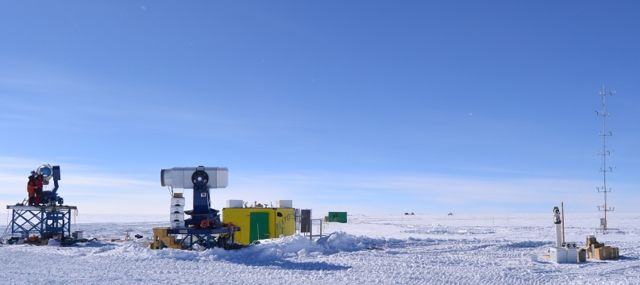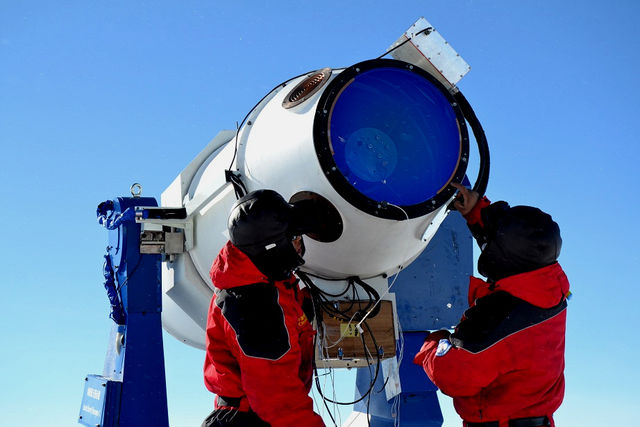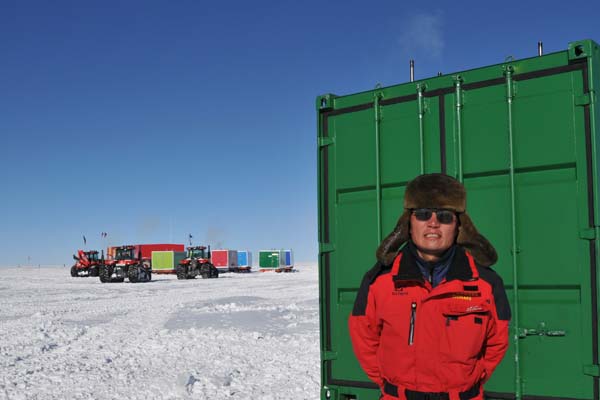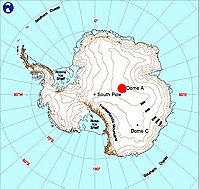Dome A, Antarctica
Over a decade of site testing in Antarctica has shown that the Antarctic plateau contains exceptional sites for astronomy, with certain atmospheric conditions (e.g., turbulence, water vapour content, and infrared emission) that are greatly superior to those at existing mid-latitude observatory sites.
Dome A is the highest summit of the Antarctic plateau at an altitude of 4,100m. It is the location of the Chinese Kunlun inland station.
Telescopes at Kunlun Station, Dome A
Currently, the main telescope at Kunlun Station is AST3-2, which is a 0.5 metre aperture optical telescope with a camera based on an STA CCD with an active area of 10560 x 5280 pixels and a Sloan i-band filter. The scale is 0.997 arcseconds per pixel, giving a field of view of 2.92 x 1.46 degrees (4.3 square degrees). The main science has been exoplanet transits in the TESS southern continuous viewing zone, supernovae, and variable stars. More information on the telescope and data analysis is available here. The data (approximately 12 TB per year) from 2016 and 2017 are available - please contact Michael Ashley if you are interested.
In 2022 we expect to have the Kunlun Infrared Sky Survey (KISS) operational. The telescope will be AST3-3 with the same optical specifications as AST3-2. The KISS camera is a 1024 x 2048 HgCdTe array and filter for 2.4 microns, the darkest part of the sky from the Antarctic plateau. There is a proposal to put a 2.4 micron infrared camera on the ASTEP-400 telescope at Dome C in collaboration with France, with a similar timescale to KISS.
In 2025, depending on funding, China aims to have two major new telescopes at Kunlun Station: KDUST (a 2.5 metre optical/IR telescope) and DATE-5 (a 5 metre terahertz telescope). The science case for KDUST is published in a series of three papers.
The PLATO-A observatory
PLATO-A, the PLATeau Observatory for Dome A, is a self-contained automated platform for conducting year-round experiments completely robotically from the Antarctic plateau. It is the result of a scientific collaboration between universities in China and Australia.
PLATO-A runs without any human intervention on site. In fact, the closest person is over 950km away and there is no possibility of any maintenance to PLATO-A apart from a 3-4 window in January each year. PLATO-A has to generate its own electricity and heat, and is responsible for its own internet connectivity.
PLATO-A was taken to the Chinese Kunlun station at Dome A by the Chinare expedition in late 2011 by a 1000km tractor traverse over a period of two weeks. PLATO-A is situated at a longitude of 77:05.74, a latitude of -80:25.043, and an elevation of 4100m (as measured with the GPS in the PLATO-A Iridium OpenPort satellite communications system). PLATO-A arrived at Dome A in early January 2012, and began collecting scientific data shortly thereafter.
PLATO-A is an evolution of the original PLATO experiment that began operation at the Chinese Kunlun station at Dome A in January 2008. The original PLATO ran continuously for 204 days in 2008, and, following servicing missions in early 2009, 2010, and 2011, ran continuously throughout each of those three years.
 PLATO-A at Dome A, January 2015. The Instrument Module is yellow, the Engine Module is green and in the background. The AST3-1 telescope is at far left pointing towards the photographer. AST3-2 is to its right. The meteorological tower is at the right (credit: Fujia Du).
PLATO-A at Dome A, January 2015. The Instrument Module is yellow, the Engine Module is green and in the background. The AST3-1 telescope is at far left pointing towards the photographer. AST3-2 is to its right. The meteorological tower is at the right (credit: Fujia Du).
Power systems and control
 The AST3-2 telescope at Dome A, January 2015 (credit: Fujia Du).
The AST3-2 telescope at Dome A, January 2015 (credit: Fujia Du).
PLATO-A consists of two fibreglass modules, each the size of a standard 10-foot shipping container and weighing 1.8 tonnes—light enough to be transported using a helicopter. The Engine Module contains five Hatz 1B30 diesel engines and 6000 litres of Jet-A1 fuel. The Instrument Module is placed 50m away and contains the computer systems, battery bank, power supplies, and science instruments. Solar panels and the remaining instruments are external to both modules. The modules are extremely well thermally insulated.
The two modules are linked by a 120VDC cable that distributes up to 3kW of electrical power. A CAN (Controller Area Network) bus is used to control the modules. Solar panels provide an additional peak output of 1.3kW of electricity during the summer time, allowing operation almost entirely on solar power for several months of each year.
The PLATO-A computer system is based on two redundant PC/104 systems (Parvus ISIS/XL), each with an Iridium satellite modem for remote control and capable of transmitting up to 20MB of science data per day. An Iridium OpenPort system provides 128 kbps always-on internet connectivity. The computers boot from internal flash memory tested for low temperature and high altitude performance. A readonly filesystem is used for the Debian GNU/Linux "wheezy" operating system to maximise reliability.
Instruments
PLATO-A is an international collaboration, with instruments contributed from China, Australia, and the US.
The height of the turbulent boundary layer between the ground and smooth air is of great interest to optical astronomers. The Earth's atmosphere makes the stars (and all other objects) twinkle in a similar way to a pebble seen through a rippling stream. If the boundary layer is very low, as it is predicted to be at Dome F, it becomes feasible to build telescopes on small (10–20m high) towers, greatly simplifying or even eliminating the adaptive optics needed to remove the effects of a turbulent atmosphere. Snodar is an acoustic radar that probes the atmospheric turbulence, mapping the height of the boundary layer and other atmospheric structure.
The original PLATO observatory
As part of the PANDA and Astropoles programs of the International Polar Year (IPY), an agreement was signed between the the National Astronomical Observatories of the Chinese Academy of Sciences (NAOC), the Polar Research Institute of China (PRIC), and the University of New South Wales (UNSW) to develop and deploy an autonomous observatory called PLATO to Dome A. The PANDA traverse successfully delivered PLATO to Dome A in January 2008. A large international team has contributed to PLATO and its instruments, with Iridium satellite communication being provided by the U.S. Antarctic Program (USAP).
PLATO consists of two modules built into 10-foot shipping containers. The Engine Module contains six Hatz 1B30 diesel engines and 4000 litres of Jet-A1 fuel. The Instrument Module is 45m away and contains the computer systems, battery bank, power supplies, and some of the science instruments. Solar panels and some of the other instruments are external to both modules. The modules are extremely well thermally insulated.
 PLATO - roll mouse over image to identify objects (Zhenxi Zhu: 27 Jan 2008)
PLATO - roll mouse over image to identify objects (Zhenxi Zhu: 27 Jan 2008)
The PLATO 2008-2009 servicing mission
The PLATO observatory is designed for yearly servicing. This includes replacing the diesel engines and refilling the fuel and oil tanks.
After our first year of operation, we performed a number of upgrades to the engine module. There were also several new scientific instruments to install and commission.
Xuefei Gong, the astronomer on the PRIC 2008-2009 Dome A expedition, visited the University of New South Wales for a number of months in 2008 to help prepare the servicing mission. The other Dome A expeditioners were tasked with building a summer station at Dome A that will be upgraded to a full-year manned research station in the future.
On November 7 2008, the PRIC expedition left Fremantle for Zhongshan station on the Xue Long, a Chinese research ice breaker. The Chinese expedition reached Dome A in early January 2009 via overland traverse. Once at Dome A, Xuefei and other heroic volunteers from his team began work on making PLATO fully operational again before leaving Dome A on the 3rd of February 2009.
The PRIC expedition was extremely successful, finishing the summer station and completely servicing PLATO.
 Xuefei Gong standing in front of the newly serviced engine module (Jan 2009)
Xuefei Gong standing in front of the newly serviced engine module (Jan 2009)
Instruments
Th original PLATO was an international collaboration, with instruments contributed from Australia, China, New Zealand, the United Kingdom, and the United States of America.
CSTAR is an array of four 14.5 centimetre telescopes with each having a different filter in the optical band. CSTAR will take advantage of the months of continuous darkness to search for time varying events such as the transit of planets, supernovae, and will accurately measure the sky background brightness.
The preHEAT telescope is mapping the Milky Way in the sub-millimeter band to confirm the atmospheric transmission in this region. Atmospheric modelling indicates that Dome A is probably the only place on Earth that can routinely observe at the terahertz frequencies crucial to the understanding of the interstellar medium, and in particular the life cycle of stars.
The height of the turbulent boundary layer between the ground and smooth air is of great interest to optical astronomers. The Earth's atmosphere makes the stars (and all other objects) twinkle in a similar way that a pebble seen through a rippling stream appears distorted. If the boundary layer is very low, as it is predicted to be at Dome A, it becomes feasible to build telescopes on small towers, greatly simplifying or even eliminating the adaptive optics needed to remove the effects of a turbulent atmosphere. SNODAR is an acoustic radar that probes the atmospheric turbulence, mapping the height of the boundary layer and other atmospheric structure. A second boundary layer experiment, DASLE, is an array of sonic anemometers placed along a fifteen meter tower. These measure the wind velocity and direction.
The Nigel instrument is both a site-testing and scientific instrument designed to measure the optical sky brightness and the aurora contributions of the Dome A sky.
Gattini is an astronomical camera designed to accurately measure the sky brightness in a range of different wavelengths and cloud cover. These parameters are essential to predict the uninterrupted length of time a large telescope can observe for, and how deep into space it can see.
Participating institutions in alphabetical order
Funding agencies in alphabetical order
 |
 |
 |
Astronomy Australia Limited |
 |
 |
 |
Chinese Academy of Sciences |
 |
European Commission |
 |
National Natural Science Foundation of China |
 |
National Science Foundation, USA |
 |
United States Antarctic Program |

















